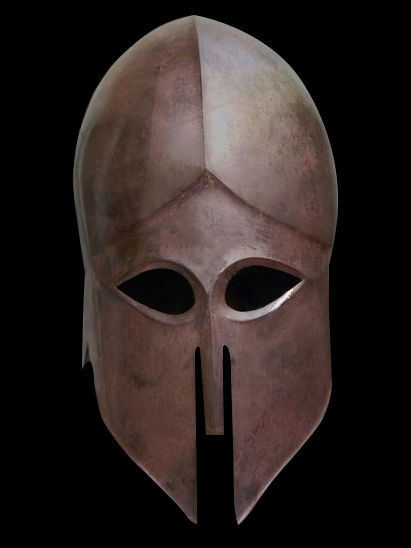

The two lines would close to a short distance to allow effective use of their spears, while the psiloi threw stones and javelins from behind their lines.

The formation was organized from eight to ten rows deep and could cover a front of a quarter of a mile or more if sufficient hoplites were available. The military structure created by the Spartans was a rectangular phalanx formation. Before the opposing phalanxes engaged, the light troops would skirmish with the enemy's light forces, and then protect the flanks and rear of the phalanx. Light infantry and missile troops took part in the battles but their role was less important. At least in the early classical period, when cavalry was present, its role was restricted to protection of the flanks of the phalanx, pursuit of a defeated enemy, and covering a retreat if required. These battles were usually short and required a high degree of discipline. The battlefield would be flat and open to facilitate phalanx warfare. When battles occurred, they were usually set piece and intended to be decisive. The vastly outnumbered Greeks held off the Persians for seven days. An example of this was the Battle of Thermopylae, where the Spartans specifically chose a narrow coastal pass to make their stand against the massive Persian army. Battles were fought on level ground, and hoplites preferred to fight with high terrain on both sides of the phalanx so the formation could not be flanked. Īrmies generally marched directly to their destination, and in some cases the battlefield was agreed to by the contestants in advance. This inevitably reduced the potential duration of campaigns and often resulted in the campaign season being restricted to one summer. The Lacedaemonian citizens of Sparta were renowned for their lifelong combat training and almost mythical military prowess, while their greatest adversaries, the Athenians, were exempted from service only after the age of 60. All hoplites were expected to take part in any military campaign when called for duty by leaders of the state. Most soldiers had careers as farmers or workers and returned to these professions after the campaign.
Best parts for a hoplite shield professional#
Limited manpower did not allow most Greek city-states to form large armies which could operate for long periods because they were generally not formed from professional soldiers.

The fragmented political structure of Ancient Greece, with many competing city-states, increased the frequency of conflict, but at the same time limited the scale of warfare. Hoplites shown in two attack positions, with both an underhand thrust and an overhand prepared to be thrown In the modern Hellenic Army, the word hoplite ( Greek: oπλίτης : oplítîs) is used to refer to an infantryman. ὁπλῖται hoplĩtai) derives from hoplon ( ὅπλον : hóplon plural hópla ὅπλα), referring to the hoplite's equipment. The word hoplite ( Greek: ὁπλίτης hoplítēs pl. The phalanx was also employed by the Greeks at the Battle of Thermopylae in 480 BC and at the Battle of Plataea in 479 BC during the Second Greco-Persian War. The Persian archers and light troops who fought in the Battle of Marathon failed because their bows were too weak for their arrows to penetrate the wall of Greek shields that comprised the phalanx formation. The formation proved successful in defeating the Persians when employed by the Athenians at the Battle of Marathon in 490 BC during the First Greco-Persian War. In the 8th or 7th century BC, Greek armies adopted the phalanx formation. Hoplite soldiers made up the bulk of ancient Greek armies. These existed at times in Athens, Argos, Thebes, and Syracuse, among others. Some states maintained a small elite professional unit, known as the epilektoi ("chosen") since they were picked from the regular citizen infantry. Most hoplites were not professional soldiers and often lacked sufficient military training.
Best parts for a hoplite shield free#
The hoplites were primarily represented by free citizens – propertied farmers and artisans – who were able to afford a linen armour or a bronze armour suit and weapons (estimated at a third to a half of its able-bodied adult male population). The formation discouraged the soldiers from acting alone, for this would compromise the formation and minimize its strengths. Hoplite soldiers used the phalanx formation to be effective in war with fewer soldiers. Hoplites ( / ˈ h ɒ p l aɪ t s/ HOP-lytes ) ( Ancient Greek: ὁπλίτης : hoplítēs) were citizen-soldiers of Ancient Greek city-states who were primarily armed with spears and shields.


 0 kommentar(er)
0 kommentar(er)
